The Single Strategy To Use For Reclaim Waste
The Single Strategy To Use For Reclaim Waste
Blog Article
Rumored Buzz on Reclaim Waste
Table of ContentsWhat Does Reclaim Waste Do?Some Ideas on Reclaim Waste You Need To KnowSome Known Incorrect Statements About Reclaim Waste The 2-Minute Rule for Reclaim WasteThe Ultimate Guide To Reclaim Waste
Residential sewage waste refers to the waste and products from a household septic storage tank. The appropriate monitoring and disposal of residential sewage waste call for liquid waste to be moved to a sewage treatment plant where the correct techniques and tools are applied to detoxify and dispose of waste.
Commercial waste typically consists of potential risks, such as flammable products or a mixture of liquid and solid waste products, and calls for an advanced and in-depth disposal procedure. The disposal of business waste commonly involves the filtration of waste before transportation to make sure secure and correct disposal. Hazardous waste is created from byproducts and runoff of industrial procedures and production.
This type of waste can not use the very same sewer monitoring transportation or processes as septic or commercial liquids. The industrial waste administration procedure requires the assessment and testing of fluid waste before it goes through the disposal process (liquid waste removal). Runoff waste is the liquid waste that originates from drainage and excess stormwater in very booming locations or cities
Runoff waste can create contamination and flooding if not managed properly. Making sure appropriate waste administration can protect against catastrophes and decrease environmental harm.
9 Simple Techniques For Reclaim Waste
Contact PROS Solutions today to learn more about our waste monitoring and disposal services and the appropriate ways to care for the liquid waste you create.
(https://www.mixcloud.com/reclaimwaste1/)Do you know what happens to your water when you draw the plug, flush the commode or drain the cleaning maker? No? Well, it deserves understanding. This so-called 'wastewater' is not just an important source but, after therapy, will be launched to our land, rivers or the ocean. Utilized water from commodes, showers, baths, cooking area sinks, laundries and industrial processes is called wastewater.

water used to cool equipment or tidy plant and devices). Stormwater, a form of wastewater, is drainage that flows from farming and city areas such as roofing systems, parks, gardens, roadways, courses and gutters into stormwater drains pipes, after rainfall. Stormwater moves neglected straight to regional creeks or rivers, at some point reaching the sea.
The Best Guide To Reclaim Waste
In Queensland, most wastewater is treated at sewage treatment plants. Wastewater is transported from domestic or industrial sites through a system of sewers and pump stations, known as sewerage reticulation, to a sewer treatment plant. Regional governments construct, keep and run most sewer therapy plants. Operators are certified under the Environmental Management Act 1994 to release cured wastewater at an acceptable environmental standard into rivers.
The Department of Natural Resources recommends local federal governments concerning handling, operating and preserving sewerage systems and therapy plants. In unsewered areas, city governments may need householders to mount private or home sewer treatment systems to treat residential wastewater from bathrooms, kitchens, restrooms and laundries. The Division of Natural Resources authorizes the usage of family systems when they are shown to be effective.
In some new communities, treatment of some stormwater to remove clutter, sand and gravel has actually begun using gross toxin catches. Wastewater therapy happens in four stages: Eliminates strong issue.
Wastewater then streams into big tanks where solids resolve and are removed as sludge. Oil and scum are skimmed from the surface area. Uses tiny living microorganisms understands as micro-organisms to break down and get rid of staying liquified wastes and great bits. Micro-organisms and wastes are included in the sludge. Removes nitrogen and phosphorus nutrients that could create algal blooms in our waterways and intimidate aquatic life.
Everything about Reclaim Waste
Nutrient elimination is not readily available at all sewer therapy plants due to the fact that it calls for costly specialist devices. Clear liquid effluent click resources generated after therapy may still contain disease-causing micro-organisms - liquid waste removal melbourne.

The majority of wastewater streams right into the sewerage system. Under the Act, regional governments carry out approvals and permits for environmentally appropriate tasks (Periods) involving wastewater launches that could have a neighborhood effect.
Reclaim Waste Can Be Fun For Anyone
Monitoring offers factual information concerning water top quality and can confirm that permit conditions are being satisfied. The details acquired via tracking provides the basis for making water top quality decisions.
Report this page